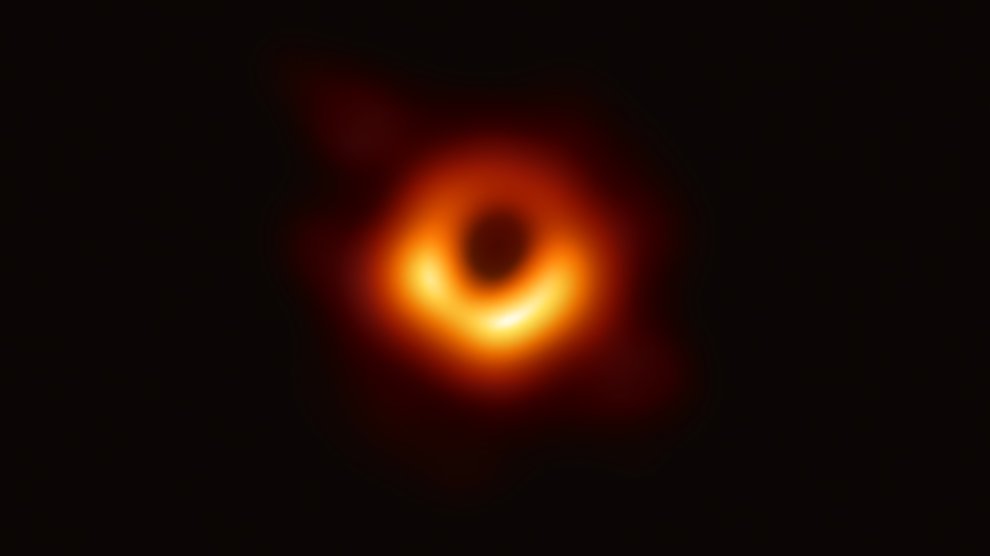You didn't get sucked into a black hole. Now what?
Not everything that crosses a supermassive black hole’s accretion disc gets spaghettified, astrophysicists say.

An image of Pōwehi, a supermassive black hole in the galaxy Messier 87. This image, which is the most detailed to date taken of a black hole, uses polarized light to reveal relativistic jets (in yellow and red) extending from Pōwehi. Image Credit: the Event Horizon Telescope Collaboration.
In March, an international network of scientists called the Event Horizon Team delivered the most detailed photograph of a black hole compiled to date. The supermassive black hole it featured, galaxy Messier 87’s Pōwehi, is 6.5 billion times as massive as the Sun and looks like a vibrant, swirling pool of flames being sucked into a dark center.
That bright ring outside the black hole—its accretion disc—is actually made up of a spiraling vortex of hot, magnetized matter. “This region itself is five times larger than the size of the black hole,” says Jordy Davelaar, a member of the Event Horizon Team and theoretical astrophysicist at Columbia University. “Though in the sky, it [looks] super tiny.”
“Tiny” to an astrophysicist, of course, is relative. If you were to orbit Pōwehi’s exact center point at a distance relative to Pluto’s orbit of the Sun, Davelaar explains, you would be within the event horizon, your orbit nowhere near its accretion disc. This means our entire solar system would fit inside this supermassive black hole’s event horizon with room to spare.
Every black hole captures material that gets too close to its event horizon, a boundary in space marking the limit of the black hole and a point of no return from it. All objects—even beams of light—that cross the event horizon will not be able to get back out. If you were to approach a black hole much smaller than Powehi feet-first, you’d feel the gravitational pull on your feet increasing much more severely than you would on your head, causing you to be stretched thin as a noodle in a process called “spaghettification.” But approach the event horizon of a huge black hole, like that of Pōwehi, and you wouldn’t get stretched: Rather, you’d gently cross the event horizon without any particular sensation at all. “You would not feel any spaghettification,” says Rutuparna Das, an astrophysicist at Harvard & Smithsonian’s Center for Astrophysics.

Astrophysicists use radio telescopes, which pick up radio waves emitted by black holes and other objects in space that don’t give off optical light, to hunt for black holes, says Rutuparna Das, who conducts research for NASA’s Chandra X-ray Observatory. Telescopes like Chandra can be used to illuminate and observe material orbiting black holes, making a black hole’s spinning accretion disc appear to glow (as seen in this image of Pōwehi from 2019). Image Credit: Event Horizon Telescope collaboration
Why would a black hole spaghettify objects in the first place? It’s a result of the black hole’s incredibly dense, gravity pit of a center called the singularity. When there is a difference in the gravitational pull of two points relative to each other, it results in what’s called tidal forces. Such forces—which surround all black holes—also affect us here on Earth. “There are tidal forces from the Moon on the Earth that we see in how our water moves,” but are too small to feel, Davelaar says. Tidal forces of black holes cause spaghettification, but because of the overwhelming mass of a supermassive black hole, you wouldn’t be spaghettified until after you crossed its event horizon. If you were to approach a black hole with a smaller mass, however, you would be spaghettified well before reaching its event horizon.
While you might avoid spaghettification due to Pōwehi’s size, you wouldn’t survive the destructive spin of its accretion disc. “The environment is super lethal,” Davelaar says. Material in the accretion disc “accelerates at such velocity it wouldn’t be pleasant for a human being,” adds Maria Charisi, an astrophysicist at Vanderbilt University. As the accretion disc spins, tidal forces shred the stars and gas clouds caught within it down to their atoms.
No longer intact, you (now broken down to your atoms) may drift toward Pōwehi’s event horizon before entering its center, where intense gravity destroys material. But first you’d visit Pōwehi’s innermost stable orbit, which looms just outside of the event horizon. The innermost stable orbit is the last place any space material has a chance to escape.
Not all material in the disc falls into a black hole, says Edo Berger, an astrophysicist at Harvard & Smithsonian’s Center for Astrophysics. It’s like “feeding a baby,” Berger says. Much like an infant may spit out mashed potatoes, a supermassive black hole may hurl from its accretion disc the remnants of its cosmic lunch of stars, dust, and other space matter in beams called relativistic jets, which can extend beyond its accretion disc into outer space.
The deciding factor of what gets consumed and what gets shot out in a relativistic jet is “whichever side is closest to the hole,” Berger says. If you were orbiting Pōwehi clockwise, the right side of you might meet its demise in the singularity while the left side of your body could be sent flying away from Pōwehi in a jet.

This color composite image of Centaurus A reveals the lobes and jets emanating from the galaxy’s central black hole. It was compiled using images taken by three instruments operating at different wavelengths: Data from LABOCA on APEX are shown in orange, X-ray data from the Chandra X-ray Observatory are shown in blue, and visible light data from the MPG/ESO 2.2 m telescope in La Silla, Chile, show background stars and the galaxy’s characteristic dust lane. Image Credit: ESO/WFI; MPIfR/ESO/APEX/A.Weiss et al.; NASA/CXC/CfA/R.Kraft et al.
The beam of a supermassive black hole’s relativistic jet can reach so far that it may even extend outside of its galaxy, Charisi says. According to a 2012 observation by the Event Horizon Team, Pōwehi’s jet extends a whopping 5,000 light-years outside of Messier 87, and the material within the jet shoots out in “clumps and knots,” NASA wrote in a January 2020 press release. NASA’s Chandra X-ray Observatory, a space telescope that detects X-ray emissions from very hot regions in the universe, discovered that Pōwehi’s jet is moving at a staggering 99% the speed of light. But as a black hole’s relativistic jet tears through the cosmos, the space material it crosses, including gas clouds, slow it down, Charisi says.
“At some point [the jet] will decelerate,” she says. “If you look at radio galaxies, you see these pencil-thin beams where the jet is accelerating, and then you see these blobs around them, where they have lost velocity.” The blobs at the decelerated ends of a relativistic jet slowly dissipate into space, says Charisi, creating a dumbbell shape around the galaxy, like that seen in images of radio galaxy Centaurus A.
Once your atoms arrive in the blob of Pōwehi’s relativistic jet, millions of years would have passed since you first ventured into its accretion disc. Though you avoided being swallowed up by the black hole, now, 5,000 light-years away from Pōwehi, your atomic remnants slowly drift apart in space. “Eventually [they] will dissipate,” Charisi says, though astrophysicists are not yet sure how long that may take.




